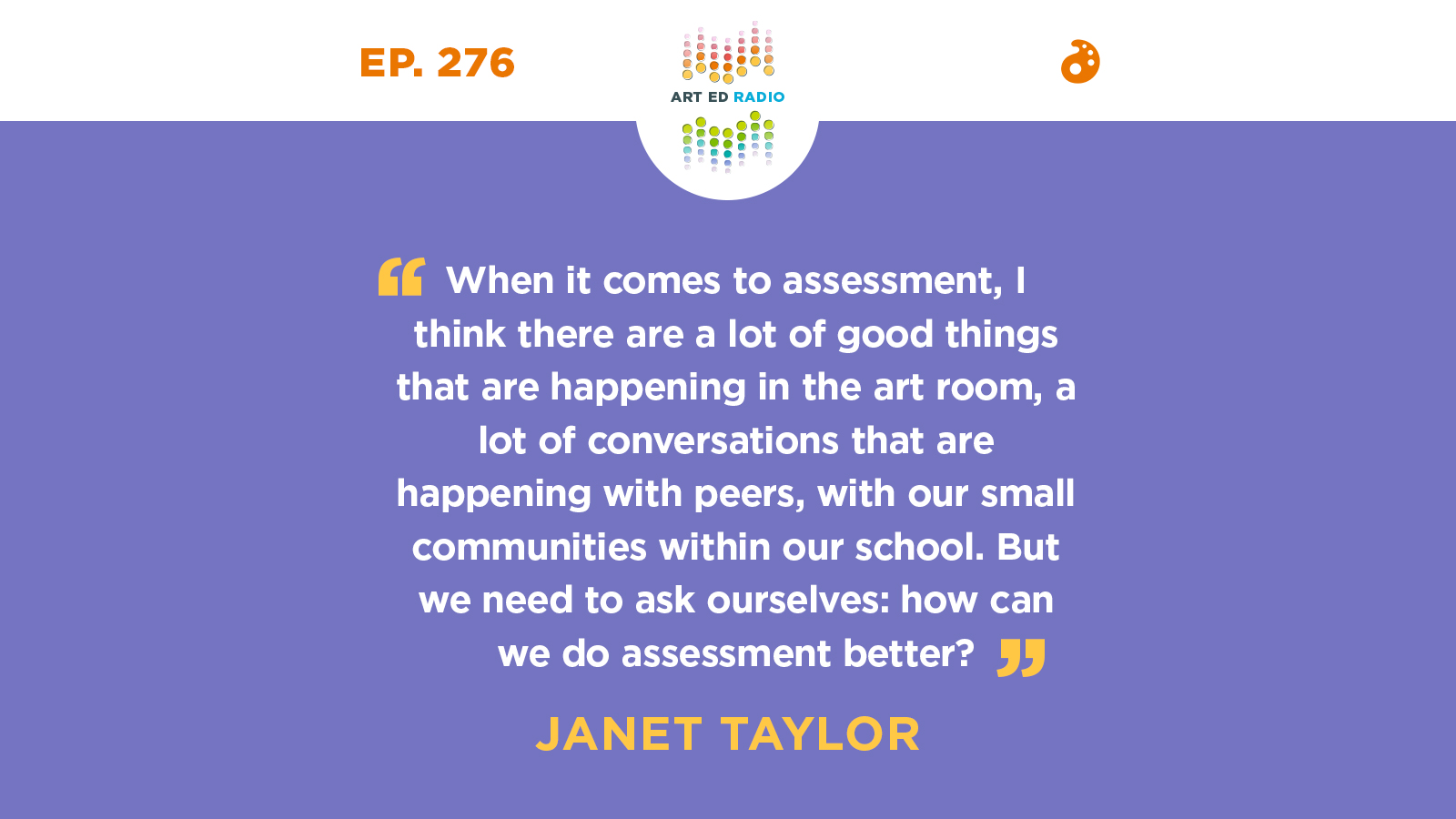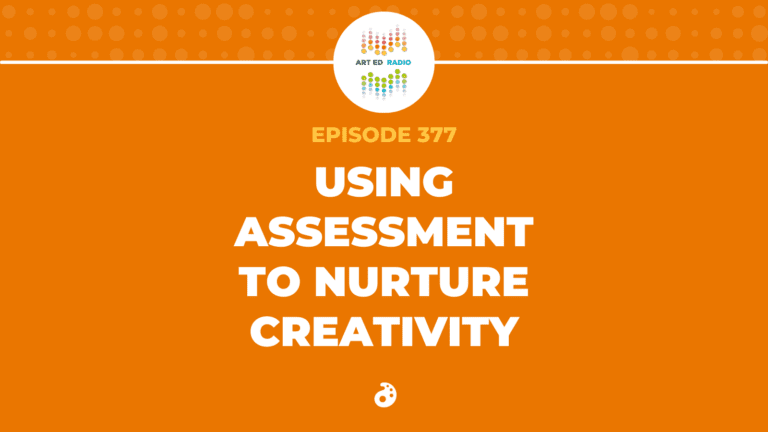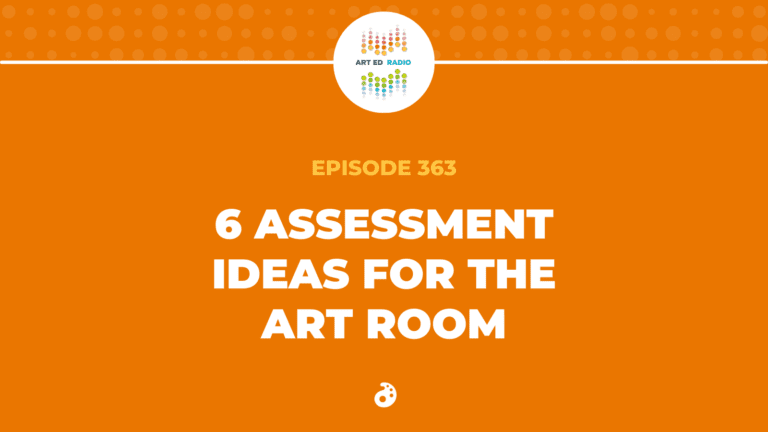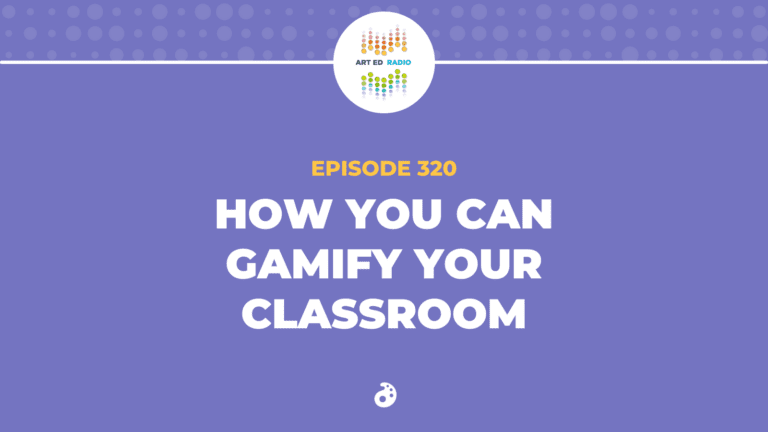We can do a lot of interesting things–and have a lot of success–when it comes to assessment in the art room. We still need to be mindful of how we handle assessment, however, and how it differs from grading. In today’s episode, Janet Taylor joins Tim to discuss her best tips for assessments, eliminating bias in grading, and why we need to reflect on our practices. Full Episode Transcript Below.
Resources and Links
- Follow Janet on Twitter
- 5 Tips for Better Art Assessments
- Check out all of Janet’s articles
- Learn all about the upcoming NOW Conference

Transcript
Tim: Welcome to Art Ed Radio, the podcast for art teachers. This show is produced by the Art of Education University, and I’m your host, Tim Bogatz.
Now whether you are a brand new teacher or an experienced teacher, you likely struggle with the idea of assessment. I did for a long, long time, and I think the biggest light bulb moment for me, the moment where things became somewhat clearer for me with assessment, is when I came to the realization that grading and assessment are two very different things. Now I’m a little bit embarrassed to tell you how many years into my teaching career that that happened, but the important point is that I made the realization. So I want to talk about that difference, the difference between assessment and grading, and talk about a lot more ideas around assessment with Janet Taylor today. Janet’s always popular, we always talk forever, but it’s always a wonderful conversation, so I’m really looking forward to that.
But before I bring her on, I want to read you just a little bit from an article that she published a few months back called Five Tips for Better Assessments. Tip number three in this article was called focus on the feedback, and Janet said this, “We all know feedback is essential for students to learn and grow. It’s important to ask yourself, how are my grades providing valuable feedback? Grading simply teaches students how do you check the box to get that A, but feedback provides students the opportunity to improve through refinement, as well as to value their process and achievements. There are different levels of feedback, daily nudges in the right direction, peer critique as they develop their critical eye, written notes on your assessments, or even one-on-one conferences, all levels of feedback are valuable to the growth of a student.”
There’s so much in there that I think is worth diving into, that I think is worth exploring, and I think we can start by focusing on not just the difference between grading and assessment, but also how we teach through assessment, and how we can provide the most valuable feedback for our students, what forms that can take, what students get out of it, and just all of the ideas surrounding that and just what it looks like in your classroom. So let me bring on Janet and we’ll hear what she has to say.
Janet Taylor is joining me now. Janet, how are you?
Janet: I am doing well, thanks for asking.
Tim: Awesome. We have lots to talk about here, about assessment, about grading. I guess I want to start with a big picture question, maybe this is too big picture, but just what is your philosophy on assessment in the art room, and what do you think we’re doing well when it comes to assessment, and what do you think we can be doing better?
Janet: Right, that is a big, that’s a loaded question. Okay, so I guess I would say I have done a ton of work on assessment in grading in the classroom, lots of research, a lot of trial and error, a lot of deep reflecting on it.
Tim: Yeah.
Janet: And of course I have a lot of thoughts on big picture education and the system, and how we can do better to serve our students and whatnot. But I think a lot of this deep reflection has come through a lot of time of figuring out my value as an educator. What do I value? What’s the purpose of education? What’s the purpose of art education? And I should say first, I guess, if you don’t know, which I know you know, is that I’m a choice art teacher, and even to get through that journey was years of trial and error and reflection and a lot of research, so same kind of place.
So I really geek out about grading and assessment and talking about it because it’s not like I just woke up and was like, I am really interested in grades and assessment. Nobody says that. But it’s been so much ingrained or intertwined, woven into my teaching as a choice art teacher, that I become very passionate about what it looks like and how we can do better as teachers. So when it comes to assessment I think there’s just a lot of good things that are happening in the art room, a lot of conversations that are happening with peers, with our small communities within our school, with our larger contacts, we are always questioning as art teachers how do you grade, or how do you assess?
Tim: Yeah, yeah, so let me ask you about that, because I think that’s something that people have always struggled with, whether you’re a first year art teacher or a 25th year art teacher, you still don’t necessarily know the best way to grade because it always does feel subjective, I guess, especially when we’re talking about some of the concepts, some of the higher order thinking skills, that we are trying to approach, that we’re trying to teach our kids about in the art room. So I’m sorry to interrupt you.
Janet: No, yeah.
Tim: But can I get your thoughts on just the subjectivity idea?
Janet: Yeah, and I think that through the years also what we have valued changes.
Tim: Yeah, yeah, it’s true.
Janet: So when I first started up I was really focused on technique.
Tim: Technical skills.
Janet: Exactly, and that’s not what we want for our students. Of course we want technical skill development, but there’s other pieces that we’re missing out on, and I think those are the pieces that we feel uncomfortable assigning letter grades or number grades to, because that’s the piece that feels subjective, like critical thinking and meaning making, refinement, and what does that look like? I think working one way, just to add, I guess, to counter that is to work within your PLC. So hopefully, I mean, I think that’s become a bigger thing nationwide now, but that has been a huge piece in working with my colleagues in my department to align everything based on our values that are not just my values, but what do my colleagues value, and where are we going both horizontally and vertically aligning all that.
Tim: Yeah, just as a department, what do you value?
Janet: Right, right, and making sure that your policies actually match up to that.
Tim: Yeah, smart.
Janet: Yeah.
Tim: So let me ask you too, I feel like a lot of teachers are struggling with what do I grade, how do I grade, or I should say assess. So what are the struggles you see when it comes to assessing art, and do you have advice on what we should get away from and what we should look toward?
Janet: Yeah, so what’s not so hot going on is when we’re looking at grading we’re either maybe grading too much, we’re looking at maybe 30 different skills or concepts that we’re teaching our students.
Tim: Right, right.
Janet: So of course we’re teaching that, of course our students are learning that, but it’s just overwhelming. And your rubrics, maybe the summative rubric is very extensive and you’re sitting there and it’s taking you hours to calculate or figure that out.
Tim: Yeah, yeah.
Janet: So that’s number one, I would say. And then we’re also oftentimes grading the wrong things. So I use reflections, artist statements, we do a lot of writing and thought process in the classroom, but I have, again, this is my trial and error, I used to grade reflections on top of their artwork, so they get separate grades. And then I realized, what am I actually grading? It’s almost a double grade, double points for that. And so I started thinking about how that actually is more evidence of learning, that that can filter into the critical thinking or refinement piece of that subjectivity that we’re talking about.
Tim: Yeah, yeah.
Janet: So you can actually identify, as opposed to assuming, or waiting and just looking at something and going, oh, I think that they did this. That’s not really helpful, right?
Tim: Mm-hmm (affirmative).
Janet: I also shifted behaviors. I think a lot of times we want to grade behaviors.
Tim: Right, like working hard, turning things in on time.
Janet: Yes, right, not studio habits of mind.
Tim: Right, right.
Janet: And even then I’m still on the fence on grading that.
Tim: Yeah.
Janet: But I feel like a student turns in late work, should we be penalizing them for that? Is there other ways that we can teach time management other than punitive scoring? I think we also grade a lot of times assumption of intent. Oh, you totally thought that through or, oh, you didn’t think that through, and you’re just like, well, how do you know that? Where’s the evidence of that?
Tim: Mm-hmm (affirmative).
Janet: And then lastly, I think grading the whole piece in the final entirety, and not actually understanding the pieces, or teaching students where their strengths and where their weaknesses or areas of improvement should be. So when we’re looking at, we might slap a grade on it and say, this is a B, we of course go through the whole process and go, okay, this and that and that, but the student might get a B, good for them, and then it’s final and that’s it.
Tim: Mm-hmm (affirmative).
Janet: And really it should be, okay, well you finished this painting, and you did a really good job with color theory, but maybe your craftsmanship needs a little bit more improvement. And I think a huge shift in education was standards based grading where you can kind of separate those out. So it’s one thing to look at a final artwork and pick that out, but it’s another thing to look at a whole semester of work and say, okay, I can see this trajectory, this trend, that overall you are excelling in technical skills, but your conceptual thinking needs some more support, so that when you go to the next level, or you go to another art classroom, your teacher has more information too about you and where they need to support you best.
Tim: Right, right. So I want to ask, this is more specific and less big picture, but when you are talking to kids about something color theory is great, craftsmanship is not as good, do you let them go back and refine? Are you willing to change grades if they go back and work on craftsmanship, or go back and work on those things where they maybe do have a deficit?
Janet: Yeah, so one thing I would say is, I’ve just been talking about grades in this part, but really it’s this assessment, and those are different than grades.
Tim: Yeah, for sure.
Janet: And so if you are assessing a student, and we can talk about that more, but if you’re assessing a student along the way, hopefully they don’t need that space as much at the end.
Tim: Right, right.
Janet: Because that can be very overwhelming too. I just spent a month working on this artwork and now I have to redo it, especially in something like ceramics, you can’t really do a whole lot after it’s been fired.
Tim: Yep.
Janet: But I personally do. I always say, if a student, again, I don’t mark down for late work, I teach my students how to set goals and deadlines and we reassess along the way, and so that’s a piece of it.
Tim: Yeah, and just communicate.
Janet: Exactly.
Tim: This is taking me longer than I thought, can I turn it in Friday instead of Tuesday?
Janet: Right, exactly, exactly that, communication, it’s a life skill.
Tim: Yes, exactly.
Janet: But if a student turns something in and I say, oh, you really need some more support with craftsmanship, and they are willing to redo it, to me that shows they’re learning. If they have the time, or want to improve their skills, why would I not reward them for that know?
Tim: Yeah, exactly, exactly.
Janet: So I do, absolutely.
Tim: Okay, good. Good to know. And then you did mention in there just a difference between assessment and grading. So can you talk about that difference and why it’s important for teachers to keep that in mind?
Janet: Yes. So again, this has been a huge shift for me to understand and see in real practice and be reflective on what’s going on, and really comes down to, what is the purpose of a grade? And so I think, okay, grades are really based on a system that’s inherently inequitable and completely biased, in my opinion, and from research and whatnot. It’s inequitable by teacher, by schools, by race and gender.
Tim: Mm-hmm (affirmative).
Janet: I used to teach in Chicago Public Schools, and now I teach in the suburbs, and so I see a huge discrepancy in funding. That alone it’s like, okay, so I started thinking about my students in Chicago Public Schools who don’t have the resources, they’re being taught in the class of 40 students, and they have other life struggles that are going way beyond, or layers of complexities. Chicago is such a highly segregated city.
And so there’s a piece of that that I think, okay, so a student who receives an A in art class in a Chicago Public School, how would that actually match up to an a and a highly funded driven community in the suburbs. Totally different situation, and I just feel like, what are we looking at, and is that really fair? It’s not. And then I think about, again, personally. So that’s the big system across the board, not even talking nationally, I was just talking within the city, but then even on the school front or the teacher-to-teacher front, it’s very biased. How are you grading? Okay, so we’re making rubrics, what are we assessing? I’m assessing something different maybe than my colleague is assessing or grading, I guess you’d say. I might be looking at behaviors, off test behavior in a kid who does the same work as another kid and I say, well, but that kid has been annoying me all year, and I’m just going to take some points off, they don’t deserve it. Or this kid really worked hard even though it’s the same, I’m going to reward them for that.
Tim: Yeah.
Janet: And that’s bias, that’s just bias. So I try to take a lot of that out and look at just evidence, and I think that helps.
Tim: Okay, so I know every teacher is tempted to do those things, and so what strategies do you have for keeping your bias out, how can you step away and not worry about, this kid is super obnoxious, or this kid is a great kid who I love working with. How do you remove yourself from that?
Janet: It’s really hard. It’s really hard. I mean, it takes a lot of reflection and thinking about what am I grading and what is the purpose of this grade? So we need to always keep in mind that grading should never be a form of punishment, it should never be punitive. So even if you are biased and say, this kid has worked really hard and I want to reward them some points, you should never deduct points from the other student.
Tim: Right.
Janet: So it’s one thing to toss a few extra points there. I still wouldn’t advise it, I don’t think that’s fair, or whatever. I think that constantly looking at evidence within your practice, so for example, if I have a rubric, I shouldn’t be assessing a student on their work ethic. I can assess them informally and give them feedback on their work ethic every single day, but when it comes to a summative assessment, I should really be focusing on the standards. Work ethic is not aligned to any standards that I know.
Tim: No.
Janet: Yeah. Sometimes things come to us easily, sometimes they’re very difficult, if the outcome is the same and the kids are hitting those standards, that’s all that really should matter when it comes to “grading,” right?
Tim: Yeah, yeah, for sure. Okay, and then just one last thing, this will be the shortest interview you and I have ever done, the shortest conversation, but I know you are going to be presenting at the NOW Conference coming up really soon. Can you just tell us a little bit about your presentation, about what specifically you’re going to be talking about, what people can learn there?
Janet: Yes, so it’s seven tips for better assessment. It is also probably the shortest presentation I’ve ever done before, but I recorded it, and then I think we’re going to be chit chatting a little bit during the conference. But basically it’s a crash course on things to consider as you’re working through your assessment practices. So a little bit more, today we talked a little bit big picture discussion on your values and what does that look like? But the presentation in the conference is more practical, dig deep, this is how you can start looking at your assessment to make it more authentic and richer. Yeah, yeah. I mean a big piece, I just need to add, I guess, remember that we were hard on grading today, but assessment is really based on improvements and feedback, and the goal of assessment is to support student growth, and so that’s more what we talk about in the conference.
Tim: Yeah, I think that’ll be good. I think I need to have you on for another podcast conversation about assessment, but I’ll just recommend that everybody come to the NOW Conference, learn there, and then maybe we can extend that next time you’re here.
Janet: Sounds great.
Tim: Awesome, thanks Janet.
Janet: Thanks, Tim.
Tim: As Janet said, nobody wakes up and says, “I’m really excited about grading and assessment.” But I think the more you think about assessment, the more you reflect on it, the more you see its importance and how it can support what you’re trying to accomplish. So it’s worth it to just spend some time with assessment. I think the first and easiest way to dive in is to read some of the articles Janet has written over the past year. They are thorough, they are well-researched, they will make you think, and if you click on all the links inside there they will take you down some serious rabbit holes when it comes to thinking about grading practices. But they will teach you a lot.
But even better, even better than those articles, come see Janet at the NOW Conference. She’s doing a presentation called seven tips for better assessment, and like Janet said, it’s just going to be a crash course with a bunch of practical hands-on ideas and really specific ways that you can create more authentic assessments for your students and for your classroom, so check it out. If you need to know more about the NOW Conference, if you still need to register, all the information you need is on the AOEU website, and we’ll link to it in the show notes.
We will also link to all of, probably can’t do all of them, but a bunch of Janet’s articles that are a good place to start, maybe a couple ideas for further exploring some of that learning, and I would just encourage you to spend some time reading and thinking and reflecting on your assessment practices. Go into it with an open mind and I think you’ll be pleasantly surprised to find that a lot of what you’re already doing is the right way to do things, is a good and beneficial way to approach assessment with students. But I think you’re also going to find some exciting new things that you might be able to do better. So like I said, read, think, reflect, and see what you can take back to your classroom, see what you can take back to make your assessments a little bit better this fall, good luck.
Art Ed Radio is produced by the Art of Education University with audio engineering from Michael Crocker. Thank you, as always, for listening, and we will be back with you again next week, which is conference week, which means excitement, and maybe a little bit of stress, but mostly excitement, and most important for podcast listeners the return of my favorite conference co-host, Amanda Hein. It’s guaranteed to be a fun one, and we will talk to you then.
Magazine articles and podcasts are opinions of professional education contributors and do not necessarily represent the position of the Art of Education University (AOEU) or its academic offerings. Contributors use terms in the way they are most often talked about in the scope of their educational experiences.



